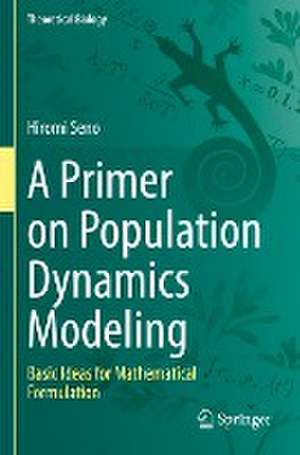A Primer on Population Dynamics Modeling: Basic Ideas for Mathematical Formulation: Theoretical Biology
Autor Hiromi Senoen Limba Engleză Paperback – 18 noi 2023
Topics covered in this book are; modeling with geometric progression, density effect in population dynamics, deriving continuous time models from discrete time models, basic modeling for birth-death stochastic processes, continuous time models, modeling interspecific reaction for the continuous time population dynamics model, competition and prey-predator dynamics, modeling for population dynamics with a heterogeneous structure of population, qualitative analysis on the discrete time dynamical system, necessary knowledge about fundamental mathematical theories to understand the dynamical nature of continuous time models. The book includes popular topics in ecology and mathematical biology, as well as classic theoretical topics.
By understanding the biological meaning of modeling for simple models, readers will be able to derive a specific mathematical model for a biological problem by reasonable modeling. The contents of this book is made accessible for readers without strong Mathematical background.
| Toate formatele și edițiile | Preț | Express |
|---|---|---|
| Paperback (1) | 536.49 lei 6-8 săpt. | |
| Springer Nature Singapore – 18 noi 2023 | 536.49 lei 6-8 săpt. | |
| Hardback (1) | 712.22 lei 6-8 săpt. | |
| Springer Nature Singapore – 18 noi 2022 | 712.22 lei 6-8 săpt. |
Preț: 536.49 lei
Preț vechi: 631.16 lei
-15% Nou
Puncte Express: 805
Preț estimativ în valută:
102.68€ • 106.80$ • 86.05£
102.68€ • 106.80$ • 86.05£
Carte tipărită la comandă
Livrare economică 14-28 martie
Preluare comenzi: 021 569.72.76
Specificații
ISBN-13: 9789811960185
ISBN-10: 9811960186
Pagini: 462
Ilustrații: XVI, 462 p. 1 illus.
Dimensiuni: 155 x 235 x 29 mm
Greutate: 0.67 kg
Ediția:1st ed. 2022
Editura: Springer Nature Singapore
Colecția Springer
Seria Theoretical Biology
Locul publicării:Singapore, Singapore
ISBN-10: 9811960186
Pagini: 462
Ilustrații: XVI, 462 p. 1 illus.
Dimensiuni: 155 x 235 x 29 mm
Greutate: 0.67 kg
Ediția:1st ed. 2022
Editura: Springer Nature Singapore
Colecția Springer
Seria Theoretical Biology
Locul publicării:Singapore, Singapore
Cuprins
Part I. Modeling Biological Factors.- Chapter 1. Application of Geometric Progression.- Chapter 2. Influence From Surrounding.- Chapter 3 .From Discrete Time Model to Continuous Time Model.- Chapter 4 Continuous Time Modeling for Birth and Death Processes.- Chapter 5. Continuous Time Modeling for Single Species Population Dynamics.- Chapter 6. Modeling of Interspecific Reaction.- Chapter 7. Modeling for Competitive Relation.- Chapter 8. Modeling for Prey-Predator Relation.- Chapter 9. Modeling with Class Structure.- Chapter 10. Modeling for Age Structure.- Part II. Mathematical Equipments.- Chapter 11. Homogeneous Linear Difference Equation.- Chapter 12. Qualitative Analysis for Discrete Time Model.- Chapter 13. First Order Linear Ordinary Differential Equation.- Chapter 14. Qualitative Analysis for Continuous Time Model.- Chapter 15. Essentials of Poisson Process/Distribution.
Recenzii
“The novelty of the book is well achieved and also is very carefully written. The meticulous deduction of classical growth models will be certainly useful for students and the proposed exercises are an excellent complement. … this book will certainly be a useful textbook in a course of population ecology for graduate students of ecology. In addition, the book provides a wide range of examples and topics for a basic course of differential equations or probabilities.” (Gonzalo Robledo, zbMATH 1519.92001, 2023)
Notă biografică
Hiromi Seno, Professor, Dr.Sci., Research Center for Pure and Applied Mathematics, Department of Computer and Mathematical Sciences, Graduate School of Information Sciences, Tohoku University.
Textul de pe ultima copertă
This textbook provides an introduction to the mathematical models of population dynamics in mathematical biology. The focus of this book is on the biological meaning/translation of mathematical structures in mathematical models, rather than simply explaining mathematical details and literacies to analyze a model. In some recent usages of the mathematical model simply with computer numerical calculations, the model includes some inappropriate mathematical structure concerning the reasonability of modeling for the biological problem under investigation. For students and researchers who study or use mathematical models, it is important and helpful to understand what mathematical setup could be regarded as reasonable for the model with respect to the relation between the biological factors involved in the assumptions and the mathematical structure of the model.
Topics covered in this book are; modeling with geometric progression, density effect in population dynamics, deriving continuous time models from discrete time models, basic modeling for birth-death stochastic processes, continuous time models, modeling interspecific reaction for the continuous time population dynamics model, competition and prey-predator dynamics, modeling for population dynamics with a heterogeneous structure of population, qualitative analysis on the discrete time dynamical system, necessary knowledge about fundamental mathematical theories to understand the dynamical nature of continuous time models. The book includes popular topics in ecology and mathematical biology, as well as classic theoretical topics.
By understanding the biological meaning of modeling for simple models, readers will be able to derive a specific mathematical model for a biological problem by reasonable modeling. The contents of this book is made accessible for readers without strong Mathematical background.
Topics covered in this book are; modeling with geometric progression, density effect in population dynamics, deriving continuous time models from discrete time models, basic modeling for birth-death stochastic processes, continuous time models, modeling interspecific reaction for the continuous time population dynamics model, competition and prey-predator dynamics, modeling for population dynamics with a heterogeneous structure of population, qualitative analysis on the discrete time dynamical system, necessary knowledge about fundamental mathematical theories to understand the dynamical nature of continuous time models. The book includes popular topics in ecology and mathematical biology, as well as classic theoretical topics.
By understanding the biological meaning of modeling for simple models, readers will be able to derive a specific mathematical model for a biological problem by reasonable modeling. The contents of this book is made accessible for readers without strong Mathematical background.
Caracteristici
Explains the biological meaning and translation of mathematical modeling for population dynamics models Provides fundamental knowledge of mathematical tools and techniques for mathematical modeling Describes mathematical modeling for non-mathematicians








